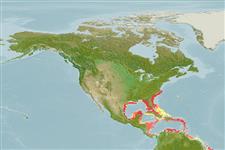>
Ophidiiformes (Cusk eels) >
Ophidiidae (Cusk-eels) > Ophidiinae
Etymology: Ophidion: Diminutive of Greek, ophis = serpent (Ref. 45335); antipholus: Named for the brothers Antipholus (Shakespeare's The Comedy of Errors), whose identities were confused throughout the play; noun in apposition.
Eponymy: The brothers Antipholus are characters in Shakespeare’s The Comedy of Errors. (Ref. 128868), visit book page.
More on authors: Lea & Robins.
Environment: milieu / climate zone / djupintervall / distribution range
Ekologi
marina bentopelagisk; djupintervall 10 - 69 m (Ref. 81834), usually 15 - 40 m (Ref. 81834). Subtropical
Western Atlantic. USA (from South Carolina to Palm Beach, Florida) and Mexico (off northern coast of Yucatan).
Size / Vikt / Age
Könsmognad: Lm ? range ? - ? cm
Max length : 21.0 cm SL hane/ej könsbestämd; (Ref. 81834)
Short description
Bestämningsnycklar | Morfologi | Morfometri
Mjukstrålar i ryggfenan (totalt) : 111 - 133; Mjukstrålar i analfenan: 94 - 103; Ryggkotor: 65 - 69. This species is characterized by the following features: D 111-133 (usually 116-123); A 94-103; pectoral fin rays 18 or 19 (rarely 20 or 21); precaudal vertebrae 15-17 (usually 16), caudal vertebrae 49-53 (usually 50-52), total vertebrae 65-69 (usually 66-68); lower arm of first gill arch with 5 or 6 developed rakers; rounded head profile with mouth distinctly inferior; dorsal and ventral profiles of body nearly parallel for much of its length; unmarked body; short and unequal pelvic-fin rays, longer reaching to point directly under anterior edge of opercle (Ref. 81834).
Body shape (shape guide): eel-like.
Observed on open sand and mud bottoms (Ref. 81834). Reproductive strategy possibly similar to other members of this family featuring oviparity, with oval pelagic eggs floating in a gelatinous mass (Ref. 205).
Life cycle and mating behavior
Könsmognad | Reproduktion | Lek | Ägg | Fecundity | Larver
Lea, R.N. and C.R. Robins, 2003. Four new species of the genus Ophidion (Pisces: Ophidiidae) from the western Atlantic Ocean. University of Kansas Museum of Natural History, Scientific Papers No. 31:1-9. (Ref. 81834)
IUCN Red List Status (Ref. 130435: Version 2025-1)
Threat to humans
Harmless
Human uses
Verktyg
Special reports
Download XML
Internet-källor
Estimates based on models
Preferred temperature (Ref.
123201): 22.9 - 27.7, mean 25.5 °C (based on 160 cells).
Phylogenetic diversity index (Ref.
82804): PD
50 = 0.5000 [Uniqueness, from 0.5 = low to 2.0 = high].
Bayesian length-weight: a=0.00102 (0.00046 - 0.00225), b=3.06 (2.88 - 3.24), in cm total length, based on all LWR estimates for this body shape (Ref.
93245).
Trofisk nivå (Ref.
69278): 3.6 ±0.7 se; based on size and trophs of closest relatives
Resiliens (Ref.
120179): Hög, lägsta populationsfördubblingstid mindre än 15 månader (Preliminary K or Fecundity.).
Fishing Vulnerability (Ref.
59153): Low vulnerability (16 of 100).
🛈
